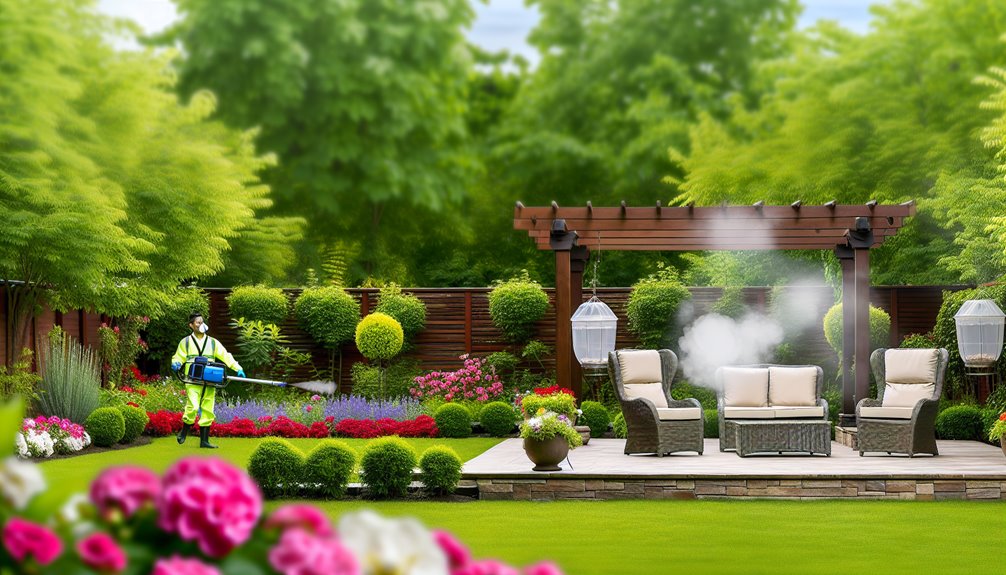Like a moat around a castle, a perimeter treatment creates a compliant, exterior barrier that limits pest access and mosquito harborage. You target foundations, eaves, and landscaping to seal entry points, cut resting sites, and reduce overall insect pressure. You time applications to weather and life cycles, select labeled products, and apply with measured coverage to avoid overuse. Done correctly, you lower mosquito activity and strengthen IPM—so what does a properly executed protocol look like?
What Perimeter Pest Control Is and How It Works

A perimeter pest control program creates a treated barrier around a structure’s exterior to prevent insects and other pests from entering. You apply labeled products to foundations, entry seams, and landscape interfaces, following PPE and reentry intervals. You confirm target species through pest identification techniques, then select formulations and rates that match pressure, substrate, and weather. You calibrate equipment, maintain uniform bands, and document lot numbers and site maps. You schedule intervals based on residual longevity and thresholds. You perform barrier effectiveness assessments using visual inspections, monitors, and complaint trends. You adjust coverage, correct conducive conditions, and record corrective actions to guarantee consistent protection.
Shared Entry Points and Harborage Zones for Mosquitoes and Other Pests
With the barrier in place, you still need to address structural gaps and nearby harborage that let mosquitoes and other pests bypass or rebuild pressure. Inspect and document entry points: door sweeps, utility penetrations, weep holes, crawlspace vents, window screens, and damaged weatherstripping. Identify moisture-rich harborage: clogged gutters, shaded clutter, wood piles, dense ivy, and under-deck voids. Remove standing water to interrupt shared breeding in birdbaths, trays, corrugated drains, tire swings, and sump discharge areas. Trim vegetation away from contact surfaces. Secure lids on refuse and recycling. Standardize a monitoring cadence, record corrective actions, and verify exclusion integrity after repairs to maintain compliance.
Building an Exterior Barrier: Foundations, Eaves, and Landscaping

Even before deploying products, define the barrier zone and its limits: foundation-to-grade interface, stem walls, slab edges, utility penetrations, eaves/soffits, fascia, and the first 3–10 feet of landscaping. You’ll inspect cracks, weep holes, and joints, then prioritize exterior sealing with compliant sealants and mesh screens. Execute foundation maintenance: repair spalls, regrade soil for positive drainage, and maintain a vegetation-free strip. For eave protection, secure soffit vents, repair fascia gaps, and clear gutters. Calibrate applications to label, targeting vertical shifts and shaded overhangs. Standardize landscaping choices: reduce dense groundcovers, elevate mulch, and prune contact points. Document findings, corrections, and reinspection intervals.
How Reducing Overall Insect Pressure Lowers Mosquito Activity
Because mosquitoes depend on surrounding microhabitats and hosts, lowering overall insect pressure reduces their resources and harborage and dampens activity. When you suppress secondary pests around structures, you limit blood-meal cues, reduce alternative hosts, and disrupt insect competition that stabilizes mosquito presence. Fewer non-target insects also mean fewer resting and feeding opportunities that shield mosquitoes.
You’ll improve site conditions by removing clutter, trimming vegetation, and targeting perimeter hotspots with label-directed applications. These actions enhance natural predators—dragonflies, spiders, bats—by opening flight corridors and decreasing refuge for mosquitoes. Maintain sanitation, fix moisture issues, and document treatments. This integrated reduction lowers biting pressure and supports client well-being.
Timing Treatments Around Weather, Seasons, and Mosquito Life Cycles

Reducing overall insect pressure sets the stage, but you’ll only sustain mosquito suppression by timing treatments to weather patterns, seasonal phenology, and the mosquito life cycle. You calibrate service windows to rainfall, temperature thresholds, and photoperiod. After measurable rain, inspect for standing water within 24–48 hours; that’s peak mosquito breeding initiation. Apply residuals ahead of forecasted rain and avoid application during high winds. Use seasonal awareness: target overwintered adults early spring, interrupt larval cohorts late spring, and tighten intervals during warm, wet peaks. Monitor degree-days to predict emergence. Document timing, labels, and reentry intervals to maintain compliance and protect clients.
Integrating Perimeter Barriers With Mosquito-Specific Strategies
While perimeter pest barriers suppress general invaders, you strengthen mosquito control by layering larval source reduction, targeted adulticide applications, and residual banding into a single, label-driven program. You map harborage, breeding microhabitats, and flight corridors, then align treatments with mosquito behavior to maximize barrier effectiveness and minimize non-target exposure. Calibrate intervals to local pressure and service expectations, documenting thresholds and outcomes.
- Protect families’ peace with discreet, dependable service
- Honor community health by reducing bite risk
- Respect property use with precise, minimal-impact actions
- Uphold trust through transparent reporting
You verify success via landing-rate counts and complaint trends, adjusting band width and frequency accordingly.
Product Choices, Application Methods, and Safety Considerations
With mosquito pressure mapped and service thresholds set, you now select chemistries and tools that meet label, state, and local requirements and fit the target sites. Choose EPA-registered actives with demonstrated product effectiveness against adult mosquitoes and occasional invaders. Match formulations (microencapsulated, wettable powder, granular) to substrates and moisture. Calibrate backpack sprayers or power rigs; verify output, droplet size, and coverage. Set application frequency from the label, weathering, and pressure data. Protect occupants, pets, and pollinators: establish reentry intervals, exclude drift, and cover or remove items. Wear required PPE, mix in ventilated areas, follow spill protocols, and document lots, rates, and areas treated.
Avoiding Overuse: Targeted Coverage and Environmental Best Practices
Start by limiting applications to verified harborages and flight paths to prevent unnecessary residues and resistance pressure. Use targeted treatments on shaded vegetation, resting surfaces, and entry points, guided by monitoring data and label directions. Calibrate equipment, verify droplet size, and document coverage zones. Preserve ecological balance by excluding blooms, water, and pollinator habitats. Schedule reentry intervals and disposal per regulation.
- Protect families and neighbors by preventing drift and off-target contact.
- Honor pollinators and aquatic life with strict buffer zones.
- Serve clients by delivering measurable, minimal-footprint outcomes.
- Safeguard communities through resistance management and recordkeeping.
Rotate modes of action; reassess hotspots post-service.
Conclusion
As the proud owner of Mosquito Eliminators of South MS, I truly believe that creating a comfortable outdoor space for you and your loved ones is essential. By treating the perimeter of your home, we can effectively keep those pesky mosquitoes at bay, allowing you to enjoy your yard without worry. If you’re interested in learning more about our services or have any questions, I invite you to visit our website at mosquitoeliminatorsms.com or give us a call at (601) 336-2277. We’re here to help you reclaim your outdoor spaces and ensure your comfort. Let’s work together to make your home a mosquito-free haven!

